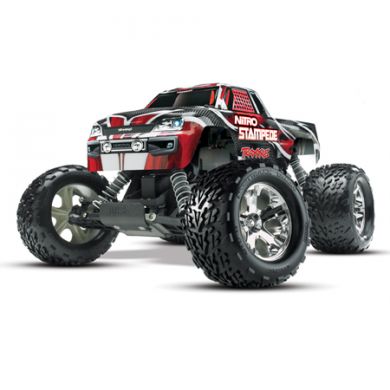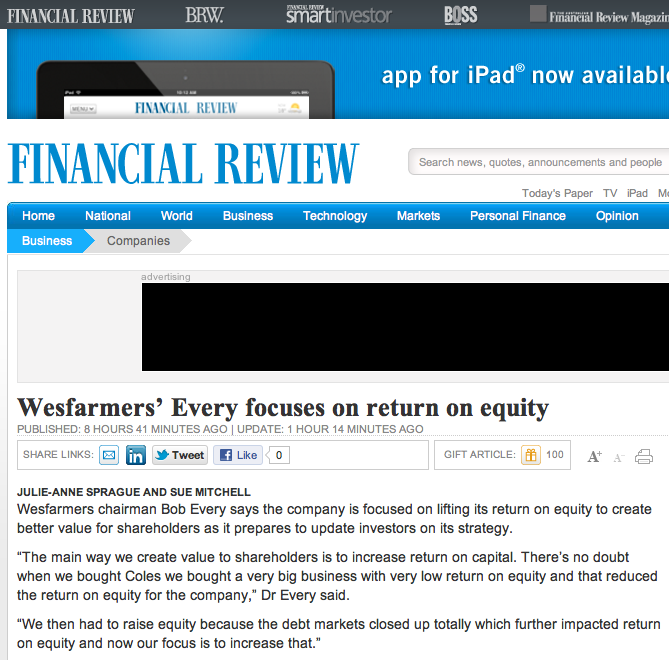Companies
-
Is this more evidence of downward pressure on commodity prices?
Roger Montgomery
July 24, 2012
 As we have been actively commenting since the start of the year, a key thematic concern we hold for investors in both Mining and Mining services businesses was the potential for commodity prices and in particular Iron Prices to begin to fall. In such an environment, falling prices would result in lower profits and cash flows for our miners and hence we could see significant future risk of projects being either scaled back or shelved in future periods.
As we have been actively commenting since the start of the year, a key thematic concern we hold for investors in both Mining and Mining services businesses was the potential for commodity prices and in particular Iron Prices to begin to fall. In such an environment, falling prices would result in lower profits and cash flows for our miners and hence we could see significant future risk of projects being either scaled back or shelved in future periods.Our view is anchored by a supply response in two new Pilbara regions coming on stream over the next few years and also falling demand from the world’s biggest consumer of additional supply, Asia (China).
With Iron Ore falling to $123.6/t, down 9% in two weeks; we are now at a critical juncture.
Critical because this is the price considered by many to be the ‘floor’ / the most Iron Ore prices can fall given China’s own estimated cost of production is $120/t. This compares to Australia/Brazil at $40/t and Canada/USA/Europe $65/t. A price lower than $120/t would make China’s Iron Ore production uneconomic and hence, a fall below this level “just cannot occur”.
Our experience with commodity producers is a little different. Our experience tells us that marginal producers are the first to lose when commodity prices fall materially.
And in this light we continue to expect over the coming months and years we will see lower prices and perhaps, marginal / high cost producers suffering and mining services starved of work. Even if they are operating at full steam right now.
To ask a question: is the recent moratorium of all Greenfield exploration activities by BHP a sign that they see the world in a similar light?
by Roger Montgomery Posted in Companies, Energy / Resources, Investing Education.
-
Is this yet-more evidence of the China slow-down?
Roger Montgomery
July 20, 2012
I thought the downgrade in earnings by a major stockbroker of the Chinese cement stocks by 20-30% for the years to December 2012 and 2013 was revealing. Anhui Conch, for example, one of China’s largest cement producers, is expecting its sales volume to grow by 17 percent per annum from 158 million tonnes in 2011 to 251 million tonnes in 2014. While the average selling price per tonne for 2012 is down 15% to 20% on 2011, and the gross margin has halved. This drives home the cyclical nature of the industry and in the past year the Anhui Conch stock price has also halved to HK$20.
by Roger Montgomery Posted in Companies, Investing Education, Market Valuation.
-

MEDIA
Are Broker valuations too high?
Roger Montgomery
July 18, 2012
Roger Montgomery certainly thinks so, and he discusses with Ticky Fullerton how his Value.able investing strategy provides much lower valuations of the current market in this interview on ABC’s The Business broadcast 18 July 2012. Watch here.
by Roger Montgomery Posted in Companies, Insightful Insights, Investing Education, TV Appearances.
-

MEDIA
A lesson for us all
Roger Montgomery
July 1, 2012
Roger provides details of the sad decline of Hastie Group (HST) in this Money Magazine article for July 2012. Read here.
by Roger Montgomery Posted in Companies, In the Press, Investing Education.
- save this article
- POSTED IN Companies, In the Press, Investing Education
-

MEDIA
Does High-Yield Focus bring exceptional returns?
Roger Montgomery
June 23, 2012
Roger Montgomery discusses why excessive focus on High Yield stocks is likely to yield disappointing returns in this Australian article published on 23 June 2012. Read here.
by Roger Montgomery Posted in Companies, In the Press, Investing Education.
- save this article
- POSTED IN Companies, In the Press, Investing Education
-
A useful Arb…
Roger Montgomery
June 14, 2012
 Amid news of Qantas’ latest conniptions and Spain’s arrival on the set of the great euro drama (Italy and France to enter stage right shortly), one Aussie company is quietly going about its business.
Amid news of Qantas’ latest conniptions and Spain’s arrival on the set of the great euro drama (Italy and France to enter stage right shortly), one Aussie company is quietly going about its business.That business is ARB Corporation (ARP), and its compelling fundamentals are the reason we have held the company’s shares in the Montgomery Private Fund since inception.
Those fundamentals have also helped to produce acceptable results for Montgomery investors (See Figure 1) amid an otherwise manic, depressive market.
Guided by its founder, Roger Brown, ARB designs, manufactures and distributes accessories for 4WD and light commercial vehicles – something it has focused on solely and successfully for almost as long as I have been alive.
And while producing and selling accessories for 4WDs doesn’t sound like an overly exciting business, consider the fundamentals over the past 10 years.
Since 2002, ARB has managed to grow its after tax earnings from $8.36 million to $37.8 million – a compound growth rate of 18.25% per annum. This is a fantastic achievement and largely organic because it has required just $133.5 million of retained profits and equity – the latter from the issuance of options.
In 2002, $8.36 million profit was generated on $31.2 million of shareholders’ equity, generating a return to owners of 26.8%. Fast forward to 2011 and returns are equally impressive. $37.8 million is being generated on $129.3 million or 29.2%. Many businesses have also grown their profits over the same period of time, but it is far more often that growth has been ‘acquired’ and declining return on equity suggests those acquisitions have been expensive.
Fig. 1 Results are net of all fees.
As the business has grown and developed its economies of scale, returns have actually improved. This is a rare achievement in practice and a development which creates significant value for shareholders.
If you were a part owner of the business in 2002, your shares would have grown steadily in value (not share price) from $1.91 to $8.09. If you believe Benjamin Graham’s observation that in the long run, the market is a “weighing machine’, then you must agree that prices follow valuations over the long run. Provided you can see which businesses are able to increase their per share intrinsic value, there is no longer any need to try and predict share prices! Simply buy high-quality businesses – with rising intrinsic values – at discounts to that intrinsic value.
Figure 2 reveals the change in the ARB’s valuation mapped against its share price over the last decade.
Fig. 2 Skaffold Line ARB and its Intrinsic value 2002-2014*
*Source: www.Skaffold.com 2012-2014 valuations are estimates
(If you have been thinking about becoming a Skaffold member, having a chart like Fig 2 above for every listed Australian company and a chart that is updated automatically and daily coming up to a Greek election, a Spain bailout and a very crucial reporting season is more than just a little helpful. I find it essential. So if you are thinking about a membership to Skaffold, go to www.skaffold.com and take advantage of the 13-months-for-the-price-of-12 “It’s Time” celebration promotion (and be sure to chat to your accountant about any pre-June 30 tax benefits)).This represents a total value increase over the period of 353.93%. Including $1.76 in fully franked dividends, the business has generated a total return over the past 10 years of 446.1%. Suddenly selling bull bars gets a whole lot more exciting doesn’t it?
Fig. 3
ARB Corporation’s rising valuation and share price clearly reflect the high-quality nature of the business and superior investment fundamentals. You can understand why it’s something we have been attracted to for some time.
Last week we asked whether Thorn Group’s (TGA) recent outperformance was sustainable. The reason to ask is because it’s not the results of the past that will deliver returns to new shareholders, but whether the future matches that which is currently estimated.
To some extent, this question was answered for ARB by its management at the start of May – “The Board expects sales for the full year to be up by about 4% and for profit after tax to be in line with the previous year.”
While it is a slightly disappointing development – the market was expecting more – we think that any growth sans acquisitions in the current economic climate is not something to sneeze at. The business has faced challenging conditions this year following the Japanese earthquake, tsunami and Thailand floods, which together dramatically impacted the supply of new 4WDs. The key risk ahead is what proportion of their sales is impacted by declining iron ore prices feeding into a lower level of capex by mining companies.
Conversely, there is pent-up demand from a lack of vehicles being available for sale in the first half. May car sales data continued to show a strong rebound and indeed a record 38,000 new 4WDs sold out of a total 96,000 in total new cars in Australia. A record and, of course, ARB’s most important business segment.
Add to this the associated pent-up demand of accessories to fit out these new vehicles and what ARB is faced with is a current order book heading into the last three months of the financial year where demand is outstripping supply. An enviable position to be in.
Coupled with a highly capable management team who have not only controlled the businesses operating expenses at a time where sales and revenues were severely impacted, but have also used their conservatively managed and high quality balance sheet to continue expanding their production and distribution capacity to support future growth plans, we think the business has not hit its straps. And remember there are less than 50 stores worldwide.
Until our view changes, which is currently unlikely, this remains to us a business that is already succeeding in expanding overseas, a business that we will happily hold and a business for whom any share price weakness (provided intrinsic value’s remain unchanged) is a signal to accumulate more.
Posted by Roger Montgomery, Value.able author, Skaffold Chairman and Fund Manager, 14 June 2012.
by Roger Montgomery Posted in Companies.
- 36 Comments
- save this article
- POSTED IN Companies
-

MEDIA
The Qantas profit downgrade – what are Roger’s insights?
Roger Montgomery
June 5, 2012
With a downgrade in forecast profit of 90%, what should investors be thinking? Share Roger Montgomery’s insights into this latest bad news for Qantas in this interview of ABC Radio’s The World Today broadcast 5 June 2012. Listen here.
by Roger Montgomery Posted in Airlines, Companies, Investing Education, Radio, Value.able.
- save this article
- POSTED IN Airlines, Companies, Investing Education, Radio, Value.able
-

MEDIA
The Market is pegging back, but is it time to start buying?
Roger Montgomery
June 3, 2012
In this edition of ABC1’s Inside Business Roger Montgomery discusses his insights into the causes of the recent market losses and how Value Investors should be interpreting the changes – Roger appears commencing 3:27. Watch here.
This program was broadcast on 3 June 2012.
by Roger Montgomery Posted in Companies, Investing Education, TV Appearances, Value.able.
-

MEDIA
What does Roger Montgomery think of Gina Rinehart’s Fairfax shareholding?
Roger Montgomery
May 30, 2012
Learn Roger’s insights into the near-term future for Fairfax Media (FXJ) as Gina Rinehart increases her shareholding in this discussion with 2GB’s Ross Greenwood broadcast 30 May 2012. Listen here.
by Roger Montgomery Posted in Companies, Investing Education, Market Valuation, Radio.
- save this article
- POSTED IN Companies, Investing Education, Market Valuation, Radio
-
Has Wesfarmers got it right?
Roger Montgomery
May 28, 2012
 In writing Value.able I wanted to explain return on equity almost as much as I wanted to introduce the idea of future intrinsic value estimates and Walter’s intrinsic value formula.
In writing Value.able I wanted to explain return on equity almost as much as I wanted to introduce the idea of future intrinsic value estimates and Walter’s intrinsic value formula.From Value.able, PART TWO, The ABC of Return on Equity:
Return on equity is essential for value investors for so many reasons and Wesfarmers purchase of Coles was a great case study:
“In 2007, Wesfarmers had Coles in its sights. In that same year, Coles reported a profit of about $700 million. In its balance sheet from the same year, Coles reported about $3.6 billion of equity in 2006 and $3.9 billion of equity at the end of 2007. For the purposes of this assessment we will accept that the assets are fairly represented in the balance sheet. Using only these numbers we can estimate that the return on average equity of Coles was around 19.9 per cent.
Importantly, Coles has been around a long time, is stable, very mature and established and supplies daily essentials. While its prospects may not be exciting, there is the possibility that Wesfarmers may improve the performance of the Coles business.
So the target, Coles, is a business with modest debt and $3.9 billion of good-quality equity on the balance sheet that generated a 19.9% return. The simple question is: What should Wesfarmers pay for Coles? If it gets a bargain, it will add value for the shareholders of their business. If it pays too much, it will do the opposite – destroy value and perhaps its reputation.
Now, if you were to ask me what to pay for $3.9 billion of equity earning 19.9 per cent (assume I can extract some improvements), I would start by asking myself what return I wanted. If I were to demand a 19.9 per cent return on my money, I would have to limit myself to paying no more than $3.9 billion. If I was happy with half the return, I could pay twice as much. In other words, if I was happy with a 10 per cent return, which I think is reasonable, I could pay $7.8 billion, or two dollars for every dollar of equity. And finally, if I think that I could do a much better job than present management, I could pay a little more, $9.75 billion perhaps.
Now suppose you consider yourself much better at running Coles than the present Coles management. Remember, this is one of the motivators for acquisitions. Suppose you believe that you can achieve a sustainable 30 per cent return on equity. Assume you were seeking a 10 per cent return on your investment – a modest return by the way, but justified by the risks involved.
The basic formula to calculate what you should pay for a mature business, like Coles, is:
Return on Equity/Required Return x Equity
Using this formula the estimated value of Coles is:
0.3/0.1 x 3.9 = $11.7 billionEven if I thought I was a brilliant retailer, I would not want to pay more than $11.7 billion for Coles. Given the risks, I may want a higher required return than 10 per cent. If I demanded a 12 per cent required return, I would not pay more than $9.75 billion (0.3/0.12 x 3.9 = $9.75).
I will explain this formula, which represents the work of Buffett, Richard Simmons and Walter in more detail in Chapter 11 on intrinsic value.
Of course, if we think that the balance sheet is overstating the value of the assets, the result would be a lower equity component and a higher return on equity. As Buffett stated:
Two people looking at the same set of facts, moreover – and this would apply even to Charlie and me – will almost inevitably come up with at least slightly different intrinsic value figures.
The result will be modestly different but the conclusion will be the same.
With around 1.193 billion shares on issue, the above estimates suggest Coles might have been worth between $8.17 and $9.80 per share.
Now, what did Wesfarmers announce they would pay for Coles? The equivalent of about $17 per share!
What do you think would happen to your return on equity if you paid the announced $22 billion for a bank account with $3.9 billion deposited earning 19.9 per cent? Your return on equity would decline precipitously to around 3.5%.”
With that in mind I wonder whether the comments Wesfarmers were reported today to have made to The Financial Review (see image, I subscribe and think its great) were complete. Of particular interest is the paragraph; “The way we create value to shareholders is to increase return on capital. There’s no doubt when we bought Coles we bought a very big business with very low return on equity and that reduced the return on equity for the company.”
Assuming the comments and statistics are correct, I would argue that the reason for the decline in Wesfarmer’s Return on Equity is not because Coles had a low ROE – as Wesfarmers are reported to have suggested – but because Wesfarmers simply paid too much for Coles. Do you agree or disagree?
What are your thoughts?
Posted by Roger Montgomery, Value.able author, Skaffold Chairman and Fund Manager, 28 May 2012.
by Roger Montgomery Posted in Companies, Consumer discretionary, Skaffold, Value.able.



